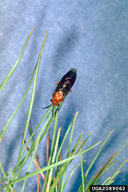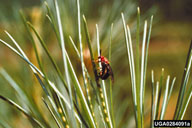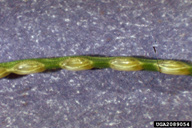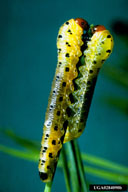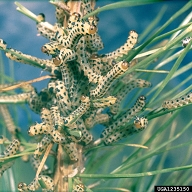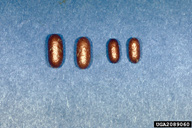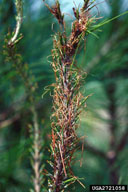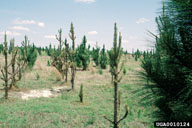Red-headed pine sawfly
Neodiprion lecontei (Fitch) (Hymenoptera: Diprionidae)
Orientation to pest
Red-headed pine sawfly, Neodiprion lecontei (Fitch), is a native North American sawfly that defoliates various pines. Conifers in other genera may also be fed on when they grow intermixed with preferred species. This sawfly is found in southeastern Canada and throughout the eastern United States. It overwinters as a prepupa in the soil. Pupation occurs in spring and adults emerge soon after. Eggs are inserted in needles of either the current or previous year's growth. A single female may lay up to 150 eggs. The larvae feed gregariously on either old or new needles, or even bark of tender twigs. Young larvae partially consume needles and cause them to dry out and curl, giving a straw-like appearance. Older larvae may consume entire needles. In some cases, trees may be completely defoliated. To prepare for winter, mature larvae drop from the foliage to the ground, where they make a spin a cocoon and molt to the pre-pupal stage. There are three generations per year in the southern United States but only one in the northern part of the United States and in Canada. This is one of the most damaging sawflies in North America. Trees at greatest risk are stressed trees growing on shallow soils, very wet or dry sites, or ones where trees are experiencing severe competition from other vegetation. Reducing vegetative competition, avoiding planting on poor sites, and using tight spacing to encourage early canopy closure are recommended to reduce damage from this sawfly to pines grown in plantations.
Hosts commonly attacked
The main hosts of red-headed pine sawfly are jack (Pinus banksiana Lambert), red (Pinus resinosa Sol. ex Aiton), shortleaf (Pinus echinata Mill.), loblolly (Pinus taeda L.), slash (Pinus elliottii Engelm.), longleaf (Pinus palustris Mill.), and pitch (Pinus rigida Mill.) pines.
Distribution
This sawfly is found in southeastern Canada and throughout the eastern United States.
Images of red-headed pine sawfly
| Figure 1. Adult red-headed pine sawfly, Neodiprion lecontei | Figure 2. Eggs of red-headed pine sawfly being laid (left) and, right, close up of eggs in pine needle | |
| Figure 3. Larvae of red-headed pine sawfly; left, close up of two and right, a large aggregation of feeding larvae | Figure 4. Cocoons of redheaded pine sawfly | |
| Figure 5. Characteristic "straw" damage caused by red-headed pine sawfly larvae | Figure 6. Damage (branches with clipped off needles) to longleaf pines by red-headed pine sawfly |
Important biological control agents related to this pest species
Important natural enemies of this sawfly include a nuclear polyhedrosis virus that has been developed in Canada as a biopesticide, the egg parasitoid Closterocerus cinctipennis Ashmead, and tachinid larval parasitoids in the genus Spathimeigenia.
Web links for information on red-headed pine sawfly
- Fact Sheet | ForestPests.org | Vermont Division of Forestry
- Entomology Publication #EENY-488 | University of Florida IFAS Extension EDIS
- Fact Sheet | Virginia Polytechnic Institute and State University
- Fact Sheet | Ohio State University Extension
Articles
- Benjamin, D. M. 1955. The biology and ecology of the redheaded pine sawfly. USDA For. Serv. Tech. Bull. No. 1118. 57 pp.
- Drooz, A. T., R. C. Wilkinson, and V. H. Fedde. 1977. Larval and cocoon parasites of three Neodiprion sawflies in Florida. Environmental Entomology 6: 60-62.
- Cunningham, J. C., P. DeGroot, and J. R. McPhee. 1984. Lecontvirus: a viral insecticide for control of redheaded pine sawfly, Neodiprion lecontei. Technical Note No. 2, Forest Pest Management Institute, Canada, 5 pp.
- Hyche, L. L. 1992.The redheaded pine sawfly (Neodiprion lecontei): a guide to recognition and habits. Bulletin No. 617 of the Alabama Agricultural Experiment Station. Auburn University, Auburn, Alabama, 11 pp.
- Wilson, L. F., R. C. Wilkinson, Jr., and R. C. Averill. 1992. Redheaded pine sawfly - its ecology and management. USDA Forest Service Handbook No. 694: 54 pp.
